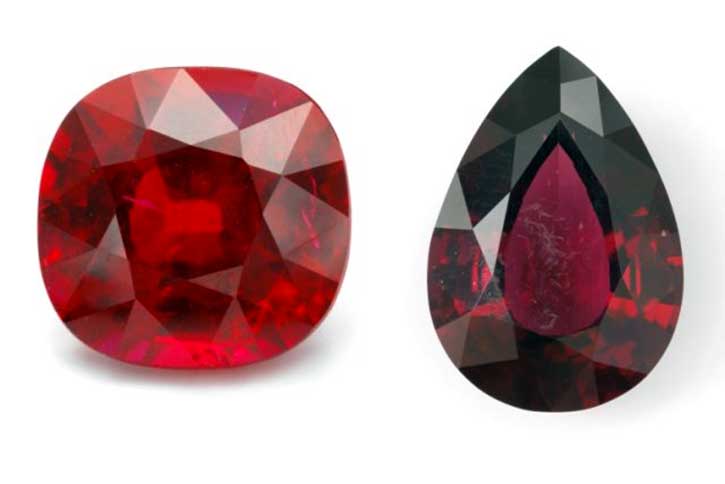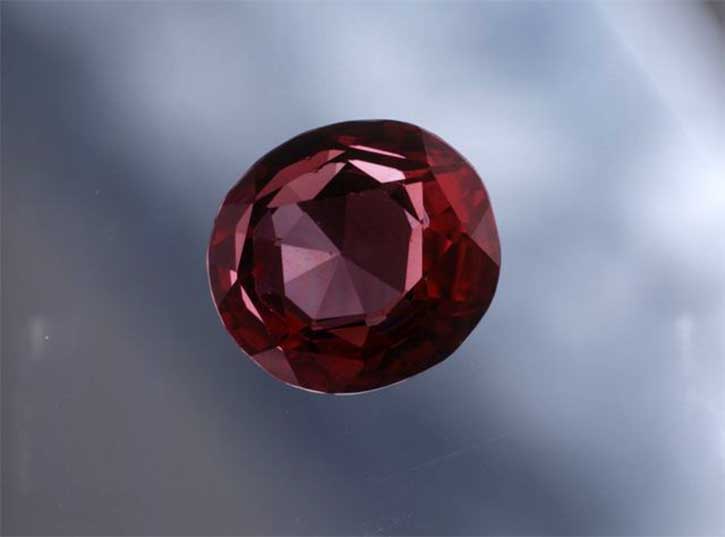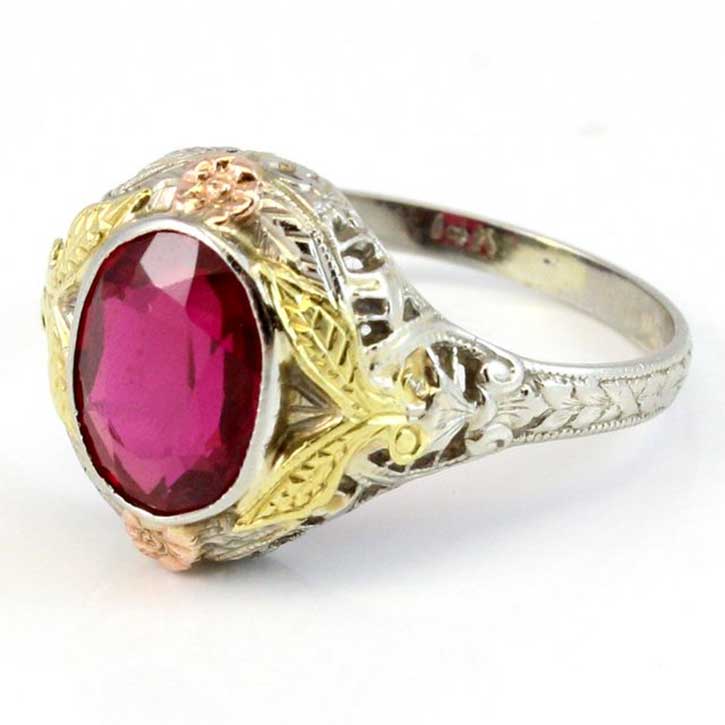Ruby is one of the 4 precious gemstones, so by definition, it is more valuable and prized than all the other semi-precious gemstones on the market. However, there have been times throughout history that less expensive spinel and garnet have been mistaken for a ruby. Today, this mishap is less common with simple gemological testing, but it is still important to know the difference between natural ruby and these three imposters.
Remember, larger sized rubies with high transparency and even color are rare, so if you have a very large stone handed down to you from someone that was never very wealthy, and that piece of jewelry is set in 10K yellow gold, it is likely you either have a largely sized garnet, a synthetic spinel, or a synthetic ruby. To know for sure, consult a local and certified gemologist.
1. Garnet

How to Tell the Difference Between Garnet and Ruby
Photo: Left is ruby and right is garnet.
Notice how in the photograph, the ruby appears redder and more cloudy than the garnet. Commercial grade rubies tend to have a light to medium red tone whereas the most common color garnet has a deeper burgundy tone. Natural garnets have higher transparency with fewer inclusions than most rubies. Largely sized rubies over 2 carats are uncommon and expensive, so if your stone is large in size as well as has a dark burgundy hue, it is likely a garnet. A small percentage of garnets do come in the same red tone as a ruby, but these are usually less than .50 carats.
To be able to fully authenticate your stone, take it to a reputable jeweler or gemologist.
2. Spinel

How to Tell the Difference Between Spinel and Ruby
Photo: Brilliant-cut spinel.
Spinel is the most common imposter of ruby, but it is also extremely underrated by the commercial jewelry world. Spinel so closely resembles the color and look of ruby that there was virtually no way to tell them apart until the late 19th century, which meant some very costly mistakes were made, like a famous spinel gemstone being placed in the crown jewels of England as a ruby. It is known to this day as the Black Prince’s Ruby. In fact, they not only have similar coloring, but also similar chemical compositions and similar locales where they are mined. Basically, the main difference between spinel and ruby is that spinel contains magnesium and ruby doesn’t. Spinel is also extremely rare and valuable, so much so that you will have a hard time finding natural red spinel in your local jewelry store. So the sad news is, there is no easy at home test to determine whether you have a spinel or ruby.
It will take a certified gemologist to be able to distinguish between a ruby and a spinel gemstone. They will first test the refractive index of the gemstone. Since ruby is doubly refractive and spinel is singly refractive, that test should be enough to decipher between the two. This test won’t, however, be able to tell you if your stone is synthetic or natural because both spinels and rubies have been manmade for well over a century.
3. Synthetic Ruby

How to Tell the Difference Between Synthetic Ruby and Natural Ruby
Photo: Flame fusion synthetic ruby from the 1920’s.
There are several different types of synthetic rubies on the market, and there are also synthetic spinels. When examining jewelry with suspect stones, there are a few things you can look for. Flame-fusion synthetic ruby is virtually flawless and has a very distinct, bright, fake looking color to it. These stones are usually set in 10K yellow gold or silver mountings. Vintage synthetics from the 1920‘s can be deceiving because they usually are in high-quality mountings surrounded by natural stones. However, some vintage synthetics from the 1940’s’ and 1950’s will be in less expensive settings with a lower quality craftsmanship. All synthetic rubies have the tendency of showing wear to the girdle more than their natural counterparts. Again, to be able to fully authenticate your stone, you will need a qualified jewelry professional with the appropriate tools to be able to test and examine your stone.
Stay up to date with the latest jewelry news and tips by following us on Facebook, Twitter, Pinterest, and Instagram.
